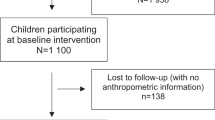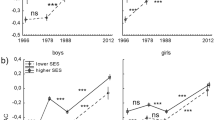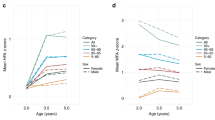Abstract
Objectives
To estimate secular changes in the body fatness, assessed using the Slaughter equation, in the context of changes in BMI in different developmental periods among Polish schoolchildren studied over nearly 50 years.
Methods
Data were collected during Polish Anthropological Surveys (1966, 1978, 1988, 2012). The total random sample consisted of 69,746 schoolchildren, aged 7–18. Three periods of development were identified: childhood, early adolescence, and late adolescence. Raw data of BMI were standardized for age classes. Based on the body fat percentage, calculated using Slaughter equation (involving triceps and subscapular skinfold thickness), fat mass (FM; kg), and then fat mass index (FMI = FM/height6; kg/m6) was assessed to enable comparison between body fatness and BMI. Statistical analyses included two-way ANOVA and post-hoc Tukey’s tests.
Results
In boys, in terms of changes per decade, between 1966 and 2012 acceleration in Z-BMI and deceleration in FMI were found, irrespective of developmental period. Regarding girls, deceleration of trend was found in terms of both features, with different intensity, depending on developmental period and year of study. The pattern of changes in FMI depending on developmental period was, to some extent, similar for both sexes.
Conclusions
Slaughter equation for abovementioned two skinfolds, as a method of body fatness assessment, might be a useful tool for research on boys across different developmental periods, but not on girls. Moreover, it should be used with caution when applied to secular changes in adiposity in both sexes, since the distribution of fat tissue varies across ontogenesis, but also over generations.
This is a preview of subscription content, access via your institution
Access options
Subscribe to this journal
Receive 12 print issues and online access
$259.00 per year
only $21.58 per issue
Buy this article
- Purchase on Springer Link
- Instant access to full article PDF
Prices may be subject to local taxes which are calculated during checkout


Similar content being viewed by others
References
Peterson CM, Su H, Thomas DM, Heo M, Golnabi AH, Pietrobelli A, et al. Tri-ponderal mass index vs body mass index in estimating body fat during adolescence. JAMA Pediatr. 2017;171:629–36.
Freedman DS, Wang J, Ogden CL, Thornton JC, Mei Z, Pierson RN, et al. The prediction of body fatness by BMI and skinfold thicknesses among children and adolescents. Ann Hum Biol. 2007;34:183–94.
Nooyens AC, Koppes LL, Visscher TL, Twisk JW, Kemper HC, Schuit AJ, et al. Adolescent skinfold thickness is a better predictor of high body fatness in adults than is body mass index: the Amsterdam Growth and Health Longitudinal Study. Am J Clin Nutr. 2007;85:1533–9.
Brannsether B, Roelants M, Bjerknes R, Juliusson PB. References and cut-offs for triceps and subscapular skinfolds in Norwegian children 4–16 years of age. Eur J Clin Nutr. 2013;67:928–33.
Juliusson PB, Roelants M, Eide GE, Hauspie R, Waaler PE, Bjerknes R. Overweight and obesity in Norwegian children: secular trends in weight-for-height and skinfolds. Acta Paediatr. 2007;96:1333–7.
Chrzanowska M, Suder A. Ontogenesis changes and sex dimorphism of subcutaneous fat distribution: 12-year longitudinal study of children and adolescents from Cracow, Poland. Am J Hum Biol. 2008;20:424–30.
Mei Z, Grummer-Strawn LM, Wang J, Thornton JC, Freedman DS, Pierson RN Jr, et al. Do skinfold measurements provide additional information to body mass index in the assessment of body fatness among children and adolescents? Pediatrics. 2007;119:1306–13.
Sarría A, García-Llop LA, Moreno LA, Fleta J, Morellón MP, Bueno M. Skinfold thickness measurements are better predictors of body fat percentage than body mass index in male Spanish children and adolescents. Eur J Clin Nutr. 1998;52:573–6.
Olds TS. One million skinfolds: secular trends in the fatness of young people 1951–2004. Eur J Clin Nutr. 2009;63:934–46.
Sedlak P, Pařízková J, Procházková L, Cvrčková L, Dvořáková H. Secular changes of adiposity in Czech children aged from 3 to 6 years: latent obesity in preschool age. BioMed Res Int. 2017;2017:2478461.
Chinn S, Rona RJ. Trends in weight-for-height and triceps skinfold thickness for English and Scottish children, 1972–82 and 1982–90. Paediatr Perinat Epidemiol. 1994;8:90–106.
Thompson AM, Baxter-Jones AD, Mirwald RL, Bailey DA. Secular trend in the development of fatness during childhood and adolescence. Am J Hum Biol. 2002;14:669–79.
Kromeyer-Hauschild K, Glasser N, Zellner K. Percentile curves for skinfold thickness in 7- to 14-year-old children and adolescents from Jena, Germany. Eur J Clin Nutr. 2012;66:613–21.
Moreno LA, Fleta J, Sarrı́a A, Rodrı́guez G, Bueno M. Secular increases in body fat percentage in male children of Zaragoza, Spain, 1980-95. Prev Med. 2001;33:357–63.
Slaughter MH, Lohman TG, Boileau R, Horswill CA, Stillman RJ, Van Loan MD, et al. Skinfold equations for estimation of body fatness in children and youth. Hum Biol. 1988;60:709–23.
Freedman DS, Sherry B. The validity of BMI as an indicator of body fatness and risk among children. Pediatrics. 2009;124:S23–34.
Wong WW, Stuff JE, Butte NF, Smith EOB, Ellis KJ. Estimating body fat in African American and white adolescent girls: a comparison of skinfold-thickness equations with a 4-compartment criterion model. Am J Clin Nutr. 2000;72:348–54.
Rodriguez G, Moreno LA, Blay MG, Blay VA, Fleta J, Sarria A, et al. Body fat measurement in adolescents: comparison of skinfold thickness equations with dual-energy X-ray absorptiometry. Eur J Clin Nutr. 2005;59:1158.
Gorny S. Measurements of the Polish youth in the year 1966. Mater i Pr Antropologiczne. 1976;92:117–66.
Hulanicka B, Brajczewski C, Jedlinska W, Slawinska T, Waliszko A, editors. City, town, village. Growth of children in Poland in 1988. Monographs of the Institute of Anthropology 7. Wroclaw: Polish Academy of Sciences; 1990.
Gomula A, Koziel S. Secular trend and social variation in age at menarche among Polish schoolgirls before and after the political transformation. Am J Hum Biol. 2018;30:e23048.
Freedman DS, Horlick M, Berenson GS. A comparison of the Slaughter skinfold-thickness equations and BMI in predicting body fatness and cardiovascular disease risk factor levels in children. Am J Clin Nutr. 2013;98:1417–24.
Wells JCK, Cole TJ. Adjustment of fat-free mass and fat mass for height in children aged 8 y. Int J Obes. 2002;26:947–52.
Hattori K, Tatsumi N, Tanaka S. Assessment of body composition by using a new chart method. Am J Hum Biol. 1997;9:573–8.
Freedman D, Wang J, Maynard L, Thornton JC, Mei Z, Pierson RN, et al. Relation of BMI to fat and fat-free mass among children and adolescents. Int J Obes. 2005;29:1–8.
Dell Inc. Dell Statistica (data analysis software system), version 13. 2016. http://www.software.dell.com. Accessed Jun 2016.
Gomula A, Nowak-Szczepanska N, Danel DP, Koziel S. Overweight trends among Polish schoolchildren before and after the transition from communism to capitalism. Econ Hum Biol. 2015;19:246–57.
Brown JD, Witherspoon EM. The mass media and American adolescents’ health. J Adolesc Health. 2002;31:153–70.
McCabe MP, Ricciardelli LA, Finemore J. The role of puberty, media and popularity with peers on strategies to increase weight, decrease weight and increase muscle tone among adolescent boys and girls. J Psychos Res. 2002;52:145–53.
Taylor RW, Grant AM, Williams SM, Goulding A. Sex differences in regional body fat distribution from pre‐to postpuberty. Obesity. 2010;18:1410–6.
Daniels SR, Khoury PR, Morrison JA. The utility of body mass index as a measure of body fatness in children and adolescents: differences by race and gender. Pediatrics. 1997;99:804–7.
Chumlea WC, Knittle JL, Roche AF, Siervogel RM, Webb P. Size and number of adipocytes and measures of body fat in boys and girls 10 to 18 years of age. Am J Clin Nutr. 1981;34:1791–7.
Malina RM. Regional body composition: age, sex and ethnic variation. In: Roche AF, Heymsfield SB, Lohman TG, editors. Human body composition. Human kinetics. Champaign, IL; 1996. p. 217–55.
Staiano AE, Katzmarzyk PT. Ethnic and sex differences in body fat and visceral and subcutaneous adiposity in children and adolescents. Int J Obes. 2012;36:1261.
Mumm R, Scheffler C, Hermanussen M. Developing differential height, weight and body mass index references for girls that reflect the impact of the menarche. Acta Paediatr. 2014;103:e312–6.
Abbassi V. Growth and normal puberty. Pediatrics. 1998;102 Suppl 3:507–11.
Cole TJ. The secular trend in human physical growth: a biological view. Econ Hum Biol. 2003;1:161–8.
Suder A, Gomula A, Koziel S. Central overweight and obesity in Polish schoolchildren aged 7–18 years: secular changes of waist circumference between 1966 and 2012. Eur J Pediatr. 2017;176:909–16.
Freedman DS, Zemel BS, Ogden CL. Secular trends for skinfolds differ from those for BMI and waist circumference among adults examined in NHANES from 1988-94 through 2009–10. Am J Clin Nutr. 2016;105:169–76.
Wohlfahrt-Veje C, Tinggaard J, Winther K, Mouritsen A, Hagen CP, Mieritz MG, et al. Body fat throughout childhood in 2647 healthy Danish children: agreement of BMI, waist circumference, skinfolds with dual X-ray absorptiometry. Eur J Clin Nutr. 2014;68:664.
Ulijaszek SJ, Kerr DA. Anthropometric measurement error and the assessment of nutritional status. Brit J Nutr. 1999;82:165–77.
Garnett SP, Baur LA, Cowell CT. The prevalence of increased central adiposity in Australian school children 1985 to 2007. Obes Rev. 2011;12:887–96.
McCarthy HD, Jarrett KV, Emmett PM, Rogers I. Trends in waist circumferences in young British children: a comparative study. Int J Obes Relat Metab Disord. 2005;29:157–62.
Moreno LA, Sarria A, Fleta J, Marcos A, Bueno M. Secular trends in waist circumference in Spanish adolescents, 1995 to 2000–02. Arch Dis Child. 2005;90:818–9.
Acknowledgements
Special acknowledgement to all contributors and researchers who were involved in the Polish Anthropological Surveys across all the years.
Funding
The 2012 Survey was funded by the National Science Centre in Poland (grant no. N N303 804540). The funding organization had no influence on the study design, data collection, analysis and interpretation, as well as on the decision to submit the manuscript for publication.
Author information
Authors and Affiliations
Contributions
AG drafted the manuscript, participated in data collection, digitalization, and prepared database. NN-S provided critical comments and edited the manuscript for intellectual content, participated in data collection, and prepared the database. AS and ZI participated in drafting the manuscript. SK organized, arranged, and coordinated the study conducted in 2012, analyzed and interpreted the data, and provided critical comments.
Corresponding author
Ethics declarations
Conflict of interest
The authors declare that they have no conflict of interest.
Additional information
Publisher’s note Springer Nature remains neutral with regard to jurisdictional claims in published maps and institutional affiliations.
Rights and permissions
About this article
Cite this article
Gomula, A., Nowak-Szczepanska, N., Suder, A. et al. Secular trends in adiposity within the context of changes in BMI across developmental periods among Polish schoolchildren—application of the Slaughter equation. Eur J Clin Nutr 75, 49–56 (2021). https://doi.org/10.1038/s41430-020-0675-7
Received:
Revised:
Accepted:
Published:
Issue Date:
DOI: https://doi.org/10.1038/s41430-020-0675-7



